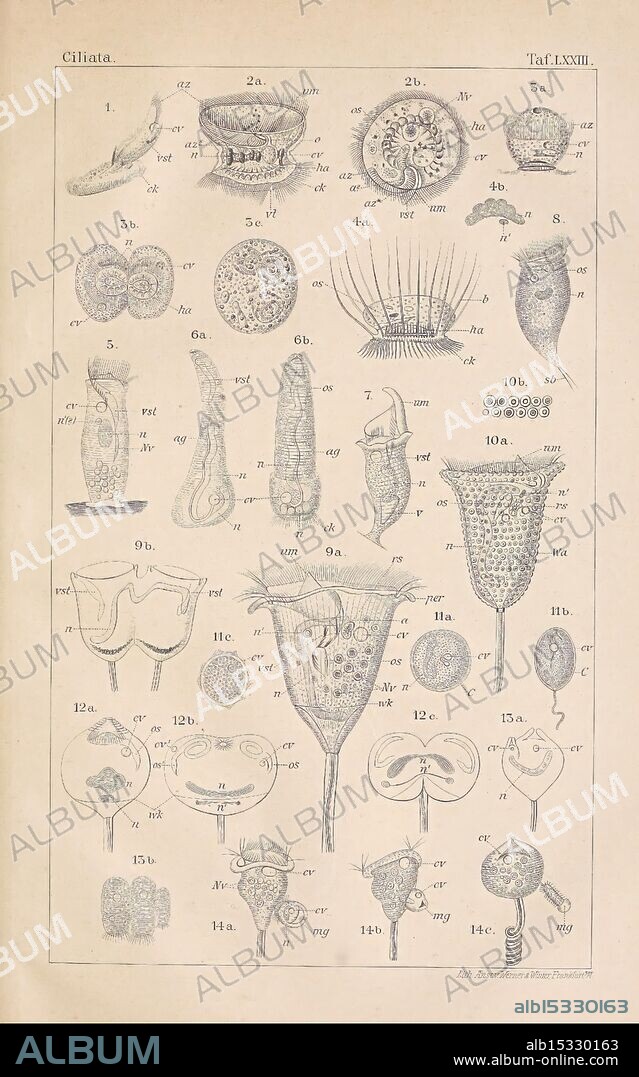alb15330163
Dr. H.G. Bronn's Klassen und Ordnungen des Thier-Reichs, Leipzig und Heidelberg, C. F. Winter, 1866-, Zoology, This illustration showcases a diverse collection of ciliates, which are a group of microscopic protists characterized by the presence of hair-like structures called cilia. The various specimens are labeled with numbers, each corresponding to distinct species or types, illustrating their unique shapes and features. Some are elongated and slender, while others are more rounded or bulbous, displaying intricate details such as contractile vacuoles and complex feeding structures. The arrangement highlights the diversity of ciliates in terms of morphology and size, offering insight into their ecological roles and functions in aquatic environments.

|
Add to another lightbox |
|
Add to another lightbox |



Buy this image.
Select the use:

Caption:
Dr. H.G. Bronn's Klassen und Ordnungen des Thier-Reichs, Leipzig und Heidelberg, C. F. Winter, 1866-, Zoology, This illustration showcases a diverse collection of ciliates, which are a group of microscopic protists characterized by the presence of hair-like structures called cilia. The various specimens are labeled with numbers, each corresponding to distinct species or types, illustrating their unique shapes and features. Some are elongated and slender, while others are more rounded or bulbous, displaying intricate details such as contractile vacuoles and complex feeding structures. The arrangement highlights the diversity of ciliates in terms of morphology and size, offering insight into their ecological roles and functions in aquatic environments.
Credit:
Album / quintlox
Releases:
Image size:
3354 x 5377 px | 51.6 MB
Print size:
28.4 x 45.5 cm | 11.2 x 17.9 in (300 dpi)
Keywords:
1866- • ARRANGEMENT HIGHLIGHTS • BRONN'S KLASSEN UND ORDNUNGEN • BULBOUS • C • CALLED • CHARACTERISTIC • CILIA • COMPLEX • CONTRACTILE VACUOLES • CORRESPONDING • DISPLAYING INTRICATE DETAILS • DISTINCT SPECIES • DIVERSE COLLECTION OF CILIATES • DIVERSITY OF CILIATES IN TERMS OF MORPHOLOGY • DR • ECOLOGICAL ROLES • ELONGATED • F • FEATURES • FEEDING • FUNCTIONS IN AQUATIC ENVIRONMENTS • GROUP OF MICROSCOPIC PROTISTS CHARACTERIZED • H. G • ILLUSTRATING • ILLUSTRATION SHOWCASES • LABELED • LEIPZIG UND HEIDELBERG • NUMBERS • OFFERING INSIGHT • PRESENCE OF HAIR- • ROUNDED • SIZE • SLENDER • STRUCTURES • THIER-REICHS • TYPES • UNIQUE SHAPES • VARIOUS SPECIMENS • WINTER • WINTERS • WINTRY • ZOOLOGY
 Pinterest
Pinterest Twitter
Twitter Facebook
Facebook Copy link
Copy link Email
Email
